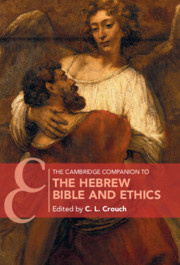Book contents
- The Cambridge Companion to the Hebrew Bible and Ethics
- Cambridge Companions to Religion
- The Cambridge Companion to the Hebrew Bible and Ethics
- Copyright page
- Dedication
- Contents
- Notes on Contributors
- Introduction
- Part I Legal Ethics
- Part II Narrative Ethics
- 6 Creation Ethics in Genesis
- 7 Migrant Ethics in the Jacob Narratives
- 8 Settler Mandates and the Book of Joshua
- 9 David’s Ethic of Togetherness and Its Victims
- 10 Ethics and Ethnicity in the Deuteronomistic History
- Part III Prophetic Ethics
- Part IV Wisdom/Poetic Ethics
- Part V Faithful Ethics
- Index
- Cambridge Companions to Religion (continued from page iii)
- References
9 - David’s Ethic of Togetherness and Its Victims
from Part II - Narrative Ethics
Published online by Cambridge University Press: 05 February 2021
- The Cambridge Companion to the Hebrew Bible and Ethics
- Cambridge Companions to Religion
- The Cambridge Companion to the Hebrew Bible and Ethics
- Copyright page
- Dedication
- Contents
- Notes on Contributors
- Introduction
- Part I Legal Ethics
- Part II Narrative Ethics
- 6 Creation Ethics in Genesis
- 7 Migrant Ethics in the Jacob Narratives
- 8 Settler Mandates and the Book of Joshua
- 9 David’s Ethic of Togetherness and Its Victims
- 10 Ethics and Ethnicity in the Deuteronomistic History
- Part III Prophetic Ethics
- Part IV Wisdom/Poetic Ethics
- Part V Faithful Ethics
- Index
- Cambridge Companions to Religion (continued from page iii)
- References
Summary
On any reading of 2 Samuel 9–20, Joab’s ruse with the Tekoite woman in 14:2–21 is a pivotal scene. It portrays the moral reasoning which David adopted in order to allow Absalom to return to Jerusalem from exile in Geshur and a new development in the ethics of David’s administration. The formal character of the king’s decision as an official royal pronouncement sets it apart and makes it especially significant. Within the narrative, the account marks a turning point from which ethical thinking in David’s court never seems to recover. The characters construct a theological ethic that places a premium on the communal “togetherness” of God’s people, and the crown accepts it as justification for overlooking the bloodguilt of one of its most marginalized members. The half-life of this ethic in the ensuing narrative wreaks havoc on the kingdom, through two of its most maniacally vulnerable agents. Once bloodguilt can be overlooked for the sake of togetherness, little remains to prevent members of the community from sanctioning the bloodshed of any member perceived to threaten that togetherness. The troubles that follow after Absalom’s return are not simply due to the mere fact that a maniacal member of God’s estate was returned to run amok. Rather, they arise from the problematic ethic employed to justify his restoration. The king’s response further exacerbates the situation. Contextualization within outworking of divine judgment on the king for his own acts of oppression adds another element to the narrative’s portrayal of causality, part of 2 Sam 8:15–20:26’s critical dramatization of David’s efforts to establish “justice and righteousness for all of his people.”
- Type
- Chapter
- Information
- The Cambridge Companion to the Hebrew Bible and Ethics , pp. 131 - 146Publisher: Cambridge University PressPrint publication year: 2021



